Winter's swan song
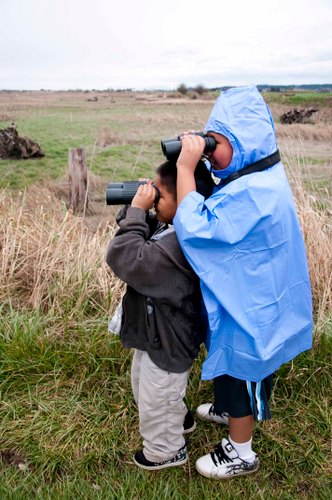
As anyone in the Skagit Valley may recall, this past Saturday wasn’t as bright and dry as some of the days previous. However, as stories like these usually begin, the weather was unsuccessful in deterring a group of enthusiastic kids from the Kulshan Creek Neighborhood Project and some equally enthusiastic adults from the US Forest Service and North Cascades Institute from partaking in a day outside learning about and observing the birds of the Samish Flats.
Our adventure began on Saturday, February 27th in the morning at the Kulshan Creek Community Center in Mount Vernon. As the students trickled in, they were met with hot chocolate—provided by a generous parent—and snacks. Lee Whitford, outreach naturalist for the Forest Service, and Orlando Garcia, of the US Forest Service, and I helped get the students situated and the day rolling.
Before we headed out onto our field trip, Don Gay, a wildlife biologist with the US Forest Service, gave a great presentation about the life history and migrational patterns of the Trumpeter Swans that temporarily inhabit the coastal farmlands of the Skagit River Valley. “Ooohs and ahhhs†were murmured throughout the room when Don explained that if a Trumpeter Swan was turned on its side with its wings out, it would have a wingspan that could reach from the floor past the ceiling of the room we were sitting in.
At the Port Susan Bay Preserve, an estuary where the Stillaguamish River combines with Port Susan Bay, our group met up with North Cascades Institute board member and Port Susan site steward, Brian Scheuch of La Conner. After a rockus game of “everybody is it!†and some fantastic peanut butter and jelly sandwiches, the students were equipped with binoculars, ponchos, and a buddy. Brian and Don took the lead, while Lee, Orlando and I aided in shepherding the large group of students onto the dike.
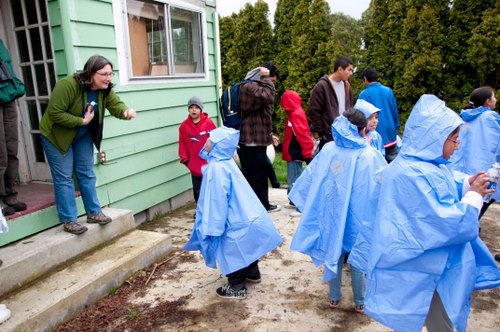 (Title) Brothers share a moment observing birds (Above) Lee Whitford gives gentle direction as the group embarks on the trail
(Title) Brothers share a moment observing birds (Above) Lee Whitford gives gentle direction as the group embarks on the trail
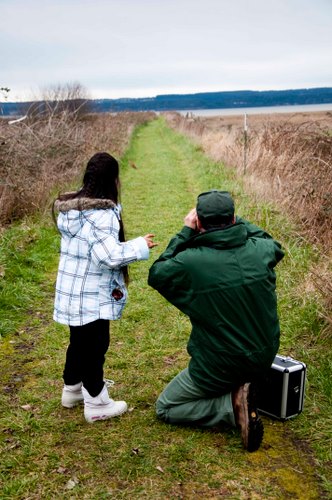 Don Gay focuses binoculars for a student to see the American Bittern ahead
Don Gay focuses binoculars for a student to see the American Bittern ahead
Almost as soon as we had begun Don spotted an American Bittern standing right in front of all of us on the path. Every student with binoculars immediately held them to their eyes to get a closer look. Don explained that bitterns were rare to see because they usually camouflage so well among reeds, although this individual stuck right on the grass green trail.
 Don Gay relates the birds on the trail to the field guide
Don Gay relates the birds on the trail to the field guide
Although it was raining, the students toughed it out and caught various glimpses of Northern Harriers, Great Blue Herons and American Wigeons—just to name a few. As we hiked along, we talked to students about the structure and lightness of bird bones and food chains that include birds and exist in estuary. About a half mile along the dike, Don set up the scope so the students could get an up-close look at the previously discussed Trumpeter Swans as they floated in the bay. At one point a student exclaimed, “What’s that smell?†To this, I replied, “It’s the estuary!â€
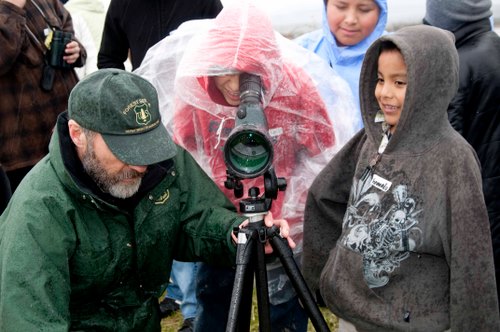 Students crowd around the spotting scope to get a look at the swans
Students crowd around the spotting scope to get a look at the swans
After a wet scramble back to the bus it was decided to take the long way home to Kulshan Creek so that the students could see some of the thousands of Snow Geese residing in the agricultural fields of Fir Island. The students gaped from the elevated bus windows at the bright white flocks of snow geese in the fields. When the road wound close enough, it was easy to hear the cacophony the geese were making.
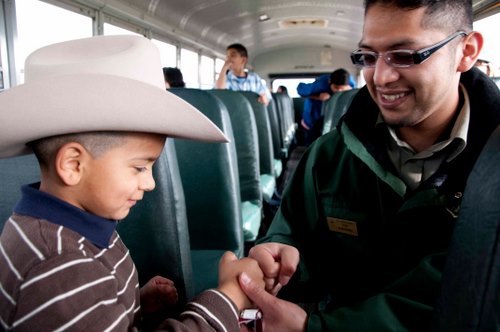 Orlando Garcia pounds five with Esteven Reyes on the bus ride home
Orlando Garcia pounds five with Esteven Reyes on the bus ride home
Back at the Kulshan Creek neighborhood, we took out our binders and reflected on our eventful, engaging day. I was amazed at the amount of facts each student could recall from the day. The Kulshan Creek Neighborhood Program goes on field trips once a month—I can’t wait to be a part of the next one!
Photos courtesy of Renee Bodine.
